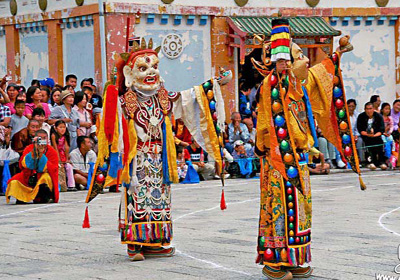 The ancient religious mask dance, or Tsam, is a
significant religious ritual which reflects Buddhist teachings through images.
It is a theatrical art performed by skilled dancers wearing magnificently
ornamented costumes, which represent characters of different holy figures and
devils, animals, and people.Through story, music, and dance, the wide range of
personalities of the characters are depicted. To symbolize positive and
negative attributes, characters from popular stories, and animals such as the
Khangarid (lord of birds), Lion (the king of wild animal), stag (the beauty
among animals), crow (the soothsayer) and various domestic animals are
imitated. Furthermore, the colors and decoration of the costumes are clues as
to the nature of the personalities of each character.
The ancient religious mask dance, or Tsam, is a
significant religious ritual which reflects Buddhist teachings through images.
It is a theatrical art performed by skilled dancers wearing magnificently
ornamented costumes, which represent characters of different holy figures and
devils, animals, and people.Through story, music, and dance, the wide range of
personalities of the characters are depicted. To symbolize positive and
negative attributes, characters from popular stories, and animals such as the
Khangarid (lord of birds), Lion (the king of wild animal), stag (the beauty
among animals), crow (the soothsayer) and various domestic animals are
imitated. Furthermore, the colors and decoration of the costumes are clues as
to the nature of the personalities of each character.
Tsam mask dancing
is included in the art form called “Doigar”, which embodies independent
imagination, one of the ten kinds of sciences according to ancient Indian
philosophy.The Tsam dance ceremony was introduced in Mongolia, in 8th century,
when the famous Indian Saint Lovon Badamjunai was invited to Mongolia to
sanctify the construction of the first Tibetan Buddhist temple, Samya. From the
time, the Tsam dance performed following the traditional teaching of
Nyambdeyan. During the 16th century, it became popular in Dash-Ihum monastery,
Uigien Namjra, and other places. Eventually, more than 500 of the 700 Mongolian
monasteries had their own local variations of the ceremony.